navigation

Originally published August 19, 2021, updated May 26, 2023
Digital marketing certainly isn’t new, but many manufacturing companies still rely on old-school promotion and lead-generation strategies instead of going digital. Modern manufacturers need to crack the digital space if they want to appeal to digitally savvy customers and thwart disruption.
In this post, we’ll look at the trends driving the digital marketing push and how it is changing traditional marketing. We’ll cover things to consider before crafting your strategy, how to prepare your business for digital marketing, and share six manufacturer-friendly digital marketing strategies. We’ll even share stories from some companies about their experience and success in bringing digital marketing and manufacturing together.
3 Reasons Why Manufacturers Can’t Ignore Digital Marketing
Manufacturers are generally early adopters of new technologies to improve their processes. But, interactions between suppliers and their customers have changed dramatically, and manufacturers have been slow to adapt.
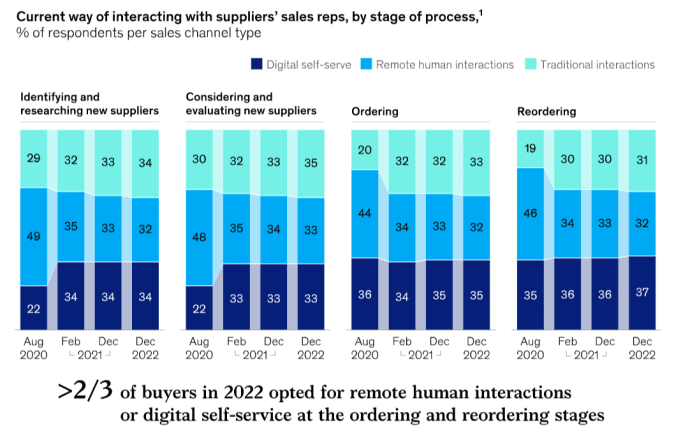
[Source]
Today’s buyers expect digital experiences
For the first time, the vast majority of B2B buyers are Gen X consumers and millennials. Millennials have grown up: over 60% of millennials currently make or influence buying decisions and have employees reporting directly to them. They reach out to companies on new channels and in new ways, and they expect to find them there.
Self-service and omnichannel is here to stay
The COVID-19 pandemic fundamentally reshaped how B2B customers purchase. And since most purchasers are millennials, it’s not surprising that 75% of B2B buyers now prefer online purchasing over in-person sales. According to the same report, B2B buyers using in-person channels expect access to digital channels and platforms that enhance their experience.
Buyers use digital channels for big-ticket items too
Despite the widespread belief that in-person contact is necessary for big-ticket purchases, 70% of B2B buyers said they’re willing to spend more than $500,000 either remotely or digitally. This means manufacturers need to utilize hybrid or omnichannel sales methods to attract customers and close deals. The need for online marketing for manufacturers will only increase.
Now that you understand the importance of digital marketing in the customer experience, let’s look at how digital is changing traditional marketing.
Types of Online Marketing
Digital or online, marketing is an all-inclusive term that describes marketing activities conducted on the Internet. There are seven primary types of online marketing for manufacturers to consider:
- Social media marketing works toward acquiring attention and sales through the use of social media platforms such as Facebook, Instagram, or Twitter.
- Influencer marketing is the process of working with people who have a large online following (influencers) to promote a product or service to their subscribers.
- Affiliate marketing essentially means online referral marketing.
- Email marketing is a form of digital marketing where you send direct marketing messages to people in an effort to gain new customers and retain and engage existing ones.
- Content marketing involves consistently creating, distributing, and promoting relevant online written and visual content so that it attracts, engages, and converts your target audience into customers.
- Search engine optimization (SEO) is the process of optimizing websites and digital content to improve search engine rankings to grow the number of visitors to a particular webpage.
- Paid advertising describes a manufacturing digital marketing approach where advertisers pay to show their ads on search engines and other online platforms, such as YouTube, LinkedIn, and Facebook.
Changes In Traditional Manufacturing Marketing
Traditionally, B2B marketing involved cold calls, direct mail, and trade show invitations. All these strategies took a hit after COVID-19.
This is hardly news to most of us. Telephones and fax machines have been falling out of favor for a long time. The lockdowns of 2020 may have temporarily knocked the wind from the sails of the trade show industry, but in-person trade events have resumed in over the last year. And they have a new feel.
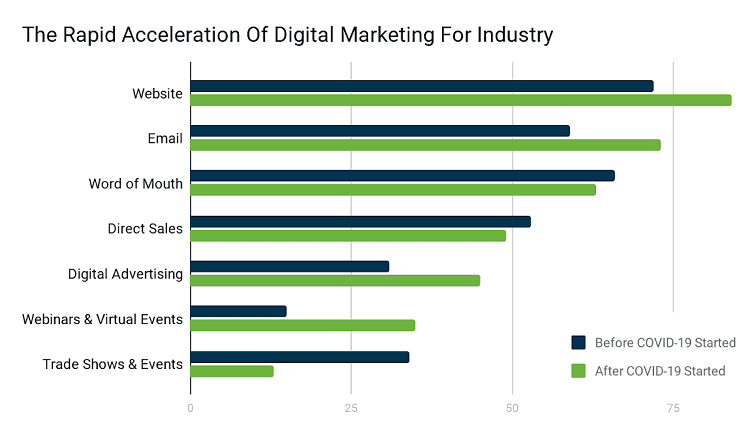
If you haven’t considered digital marketing solutions for manufacturers, now is the time to start thinking about how they can work with traditional marketing efforts to help you gain more business.
And this doesn’t only apply to manufacturers. If you’re an industrial seller, your customers are online, too.
digital marketing for distributors and industry-specific marketing tactics, you risk falling behind your competitors and losing your position in the market.
Recommended reading: Digital Marketing in the Chemical Industry
Using digital marketing with traditional marketing
Traditional marketing in the form of printed magazines and catalogs is still important, but now, they must be enhanced with digital. And as trade shows return, they have a digital feel, too.
Audiences across industries have developed an affinity for self-service and digital content consumption, so marketers need to meet the B2B buyer’s changing expectations for engagement. Marketers who can blend digital with traditional strategies will enhance the customer experience – before and during an in-person visit to the office or trade show booth.
With everyone using digital devices, you can enhance the physical catalog with QR codes so users can download specification sheets and order items on the spot. Augment trade shows and face-to-face meetings with digital events, mobile-augmented in-store experiences, and other technologies.
How to Develop a Digital Marketing Strategy for Your Manufacturing Company?
Every manufacturer is different, so it’s important to understand different strategies that support digital marketing for manufacturing. For more than 100 years, Thomas has been the go-to resource helping industrial manufacturers and B2B service providers grow their business. Based on their research and marketing campaigns with manufacturers, they discovered:
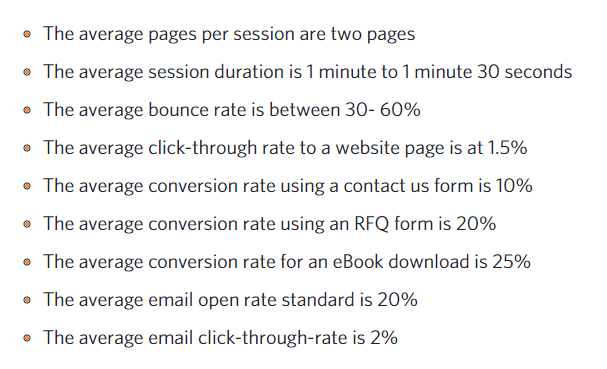
[Source]
Having benchmarks for your industry helps you set realistic goals and ensure that a digital marketing strategy for your manufacturing company is on the right track.
1. Set your marketing (and digital marketing) budget
There’s a wide variety of manufacturing industries and digital marketing budgets. On average, manufacturing companies allocate 6.4% of the company budget to marketing, which accounts for 2.7% of their revenue. If you still aren’t sure what to spend, Hivehouse recommends choosing from the following options:
- Lean plan, where 1-2% of your revenue is channeled towards marketing. This budget allowed for simple tools and strategies. It’s best suited for companies looking to maintain their market position, without ambitious growth plans.
- Target plan, where 3-4% of your revenue is allocated to marketing. This tactic is best suited for companies looking to engage with existing customers but also focus on attracting new customers. This way, manufacturers can maintain 15% annual growth and expand their market share.
- Stretch plan, where 5% or more of revenue goes towards marketing. Here, companies have more resources and freedom to drive leads, conversions, and sales. Marketers have the budget to launch more campaigns and try out new strategies. This option is ideal for manufacturers looking to significantly expand their market share and achieve a 20% or more annual growth rate.
It’s important to note that these numbers are only a guide and will vary based on your company size, marketing experience, and how customers discover you. If your customers are online, they’re doing research there too. In this case, the share of digital marketing for manufacturers might be anywhere from 1/3 to 3/4 of the overall marketing budget.
2. Assign a team to lead your marketing efforts
First, you’ll need to appoint a marketing leader to oversee your digital efforts. Any manufacturing and online marketing strategy needs a team well-versed in digital channels. Most marketing professionals will be skilled in SEO, PPC, digital content, or social media.
If you’re just getting started with digital marketing for the manufacturing industry, it may be tempting to hire one marketing expert and call it a day. While some individuals offer full-stack marketing services for manufacturers, they can only do so much. They won’t be able to give any single area their full attention. So whatever route you go, you’ll need a team of marketers to handle all the marketing elements you’ve deemed important.
Once you do that, you’ll face the question of what marketing activity to keep in-house and what to outsource to marketing agencies.
Outsourcing versus in-house
There’s nothing wrong with outsourcing to a digital marketing agency when done strategically and with preparation. Advertising agencies and internet marketing companies offer a range of services with varying pricing, and you may be tempted to fill as many of your marketing gaps as possible with external talent.
With in-house marketers, aside from salary costs, you must consider costs for training, healthcare, vacations, and other workplace benefits. While in-house teams can be costly, it’s easier to innovate, communicate, and come to a consensus on critical decisions. In-house teams can complement and maximize the results of other teams, and since they understand your product, clients, and industry, they can bring more creative solutions to complex problems.
In our report on digital marketing for manufacturers and distributors, we recommend outsourcing highly technical or non-company-specific activities like SEO, and paid campaigns, while keeping email marketing, and content marketing in-house.
3. Revisit your brand mission and values
Your brand is the image customers have of your business, so think about it carefully and clearly. According to the 2020 Renegade survey of B2B CMOs, less than half could summarize their brands in 8 words or less. If you don’t know what makes your brand different, how can you communicate your unique selling proposition to potential customers?
4. Research and segment your customers
With B2B sales, the buying team may include design engineers, procurement managers, department managers, and more. Team member purchasing motivations and inputs may be vastly different. Develop personas for each and then focus on what influences their behavior.
No matter your industry or geographic location, every purchaser is a human who makes decisions partially based on emotions. And, if buyers can reach organizational goals with more than one supplier, personal factors will factor in their decision. The image below shows various factors influencing business buyers.
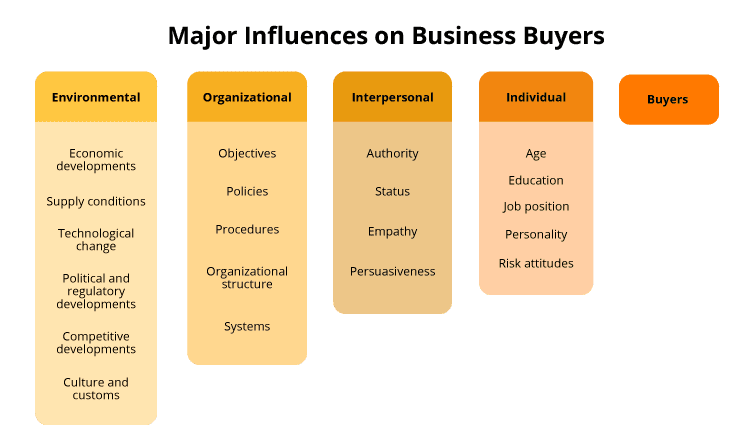
In addition, business buyers can have different attitudes towards the purchase decision:
- Price-focused customers are concerned with the price and look for the price-value balance in their purchases.
- Quality-focused customers care about quality first, seeing quality as a strategic imperative.
- Service-focused customers pay attention to post-sale support and relationships after the sale.
- Partnership-focused customers prioritize long-term, strategic, and mutually beneficial partnerships.
Separating customers into these segments can help you better allocate limited marketing resources and focus on the type of customer that will bring the most profit.
5. Analyze your competition
Your brand likely doesn’t operate in a vacuum. While you can’t change the competition, your goal should be to learn about your competitors, and appreciate their strengths and weaknesses. When you compare your brand to the competition, you’re looking at the market objectively through the customer’s eyes.
- Analyze the market: Your research may identify gaps in the market where certain customers’ needs aren’t addressed. If you know who these people are, you can change your marketing plan to reach them and make them potential customers.
- Analyze the product: When you look at what your competitors offer, you can see how your products compare. This process may lead to new product development initiatives to make your company more competitive.
- Analyze the marketing: By exploring how competitors target their customers and what marketing strategies they use, you can identify areas for improvement and update your plan to address them.
Performing any level of competitor research is a must to get a feel for your digital environment and learn from every success and failure of your peers.
6 Digital Marketing Strategies for Manufacturers
Now that you’ve laid the foundation, it’s time to pick your strategies. You may use one or all, depending on your business requirements, audience, and market position.
1. Website and mobile
Your clients see your website and mobile presence first, and that first impression forms their opinion of your business. If your website is cluttered or difficult to navigate, focus there first. At a minimum, your site should provide:
- Your history, mission, and vision
- Your team and their roles
- Easy to find contact information
- Updates section and blog
- SEO title and descriptions
- A basic product catalog or a B2B eCommerce storefront
After performing your audit, you may decide that building a new website from the ground up is the most practical course of action. In that case, exploring B2B eCommerce for manufacturers will help you build a solid foundation for your online presence.
2. Search engine optimization
SEO is probably one of the most effective but largely underestimated strategies of online marketing for manufacturing companies.
Consider this: on average manufacturers are acquiring more than 50% of website traffic from direct searches (typing the brand URL directly into the browser). This is usually the result of expanded brand awareness, not SEO.
And the challenge with only acquiring brand traffic is that at some point, you need to acquire new traffic to grow your customer base. This means you need to capture users who don’t know you.
This is where investing in a SEO strategy as part of your digital marketing activities is critical. It’s a complex part of internet marketing for manufacturers because it’s constantly evolving. It encompasses many functions, methods, and tactics which also evolve and change by the day:
Keyword research is the practice of identifying popular words and phrases people use in search engines. It provides some direction to your SEO strategy by identifying the words in high demand.
User intent is the science of deciphering what a user wants to find when searching a query into the search engine. It’s a critical component of the search engine, webpage, and conversion optimization.
SEO content refers to crafting content that is search engine friendly and appeals to your audience. Your purpose is to engage and assist your reader.
Backlink building adds links to your site from external websites. The right backlinks enhance the authority of your domain and boost your organic rankings on search engines.
Technical SEO involves tweaking code to improve searching engine performance. The goal is to increase site speed, schema markup, and canonization. Search engines increasingly consider these factors.
Mobile SEO also requires attention. Mobile usage is exploding, and Google’s ranking algorithm prioritizes websites that focus on mobile experiences.
Reporting gives you visibility and helps you track your efforts. For example, 6,000 visits a month in bot traffic is not the same as 6,000 organic visits.
In 2023 and beyond, digital marketing for the manufacturing industry must involve these SEO tactics and a strategic plan for gaining non-brand-aware traffic, to ensure that manufacturers stay relevant in the digital era.
3. PPC campaigns
With PPC or pay-per-click advertising, you pay a set amount each time someone clicks on your digital ad. You can place PPC ads on search engines like Google or Bing or social media channels like Linkedin, Facebook, and Instagram.
PPC is both simple and complex at the same time. If you target unrelated categories, it’s easy to go through your budget without seeing ROI. The best way to maximize value for your dollar is to incorporate your traffic data and customer persona data when creating your campaigns. It also helps to direct users to a specific product category or area of your website.
4. Content marketing
Content marketing creates and promotes content that will likely interest your customers. Web content can take many forms, from infographics to social media posts, blog posts, documentation, or videos. Here are content examples, ranked from top of the funnel to bottom of the funnel:
- Industry news and roundups
- Blog posts, how-to guides
- Product comparison guides
- Case studies and buyer guides
- Product or instruction videos
- Spec sheets and brochures
- Pricing calculators
It’s important to note that blog content can be especially useful for engaging with your potential customers.
In 2023, blog content is about being the go-to resource for information on a given topic. For example, if you are a manufacturer of factory equipment, the approach is to produce content on everything from which type of robotic arm to use with different machines, to how to implement industrial machinery sensors. This approach pulls in relevant users, and positions your brand as the go-to authority on information in your niche.
5. Email marketing
According to Campaign Monitor, email marketing has the highest ROI of any marketing activity. Virtually everyone reads their email every day, and sending email is an excellent way to stay in touch with existing customers and reach leads. However, creating the right email that captures attention can be a lot of work.
Most manufacturers reach individuals through email lists. These lists are a collection of email addresses of people that know about you and want to hear from you. However, lists must be continually updated by monitoring bounce backs, click rates, and deleting old contacts. Don’t forget about the message itself. Be sure to:
- Include the receiver’s name
- Use stats that grab attention
- Mention a relevant, industry event
- Create a sense of urgency
- Offer real value
Your email marketing efforts don’t begin and end with the email. To grow your list, you’ll entice people to share their information. Create landing pages that offer visitors access to a whitepaper or industry report or enable them to subscribe to your blog in exchange for their name and email address.
6. Social media
According to a Capterra survey, more than 44% of B2B survey respondents identified social media marketing as the top digital skill they need most in the coming months.
While it may not seem relevant, social media is an effective digital marketing strategy for a manufacturing company to use to grow its business. Consider that social media platforms like LinkedIn provide the lion’s share of leads for B2B companies. Twitter enables brands to speak directly to their audience. Instagram allows manufacturers to make images work for them and showcase their products in a favorable light.
Social media and podcast advertising agencies as well as internet marketing companies offer a range of services with varying pricing, and you may be tempted to fill as many of your marketing gaps as possible with external talent.
Technologies and Tools Used in Digital Marketing for Manufacturers
Digital marketers use a variety of tools to help them plan, manage, track, and execute their marketing strategies. Let’s explore some tools that can help with online marketing for manufacturing companies.
Email marketing platforms
Email marketing software helps you to set up the right infrastructure in place to handle your email marketing. With an email marketing platform in place, you’ll be better positioned to reach your subscribers and customers in the way you need to increase engagement, build positive relationships and generate more leads.
Arguably, some of the best tools for sending out emails include MailChimp, HubSpot, and ActiveCampaign. They allow you to automate your email marketing with simple A/B testing, ready-to-use campaign templates, and a simple email designer, lead capture forms, and integration with CRMs.
SEO tools
SEO tools offer in-depth analysis of websites and include features that improve visibility and rankings on search engines.
The best website ranking tools online today cover most of the following:
- What keywords the site ranks for
- Backlinks
- Site traffic
- Ranking amongst competitors
- Overall site health
- Site audits
Among the best SEO tools online to use for your digital marketing efforts are SEMRush, Ahrefs, BuzzSumo, and Moz Pro. Make sure to conduct your own research and trial different tools to truly understand which one will be most suitable for you.
Reporting and analysis tools
Proving that digital marketing campaigns are bringing ROI and creating business value is essential for digital marketers, especially in risk-averse manufacturing sectors. This is where tools that help understand your campaign performance, traffic, and user behavior come into play.
Google Analytics perhaps stands head and shoulders above the rest as a tool for monitoring how your website traffic is changing and how people interact with your site. Google’s machine learning capabilities mean that Google Analytics can generate powerful insights on the best performing content, mobile vs desktop users, demographics, and more.
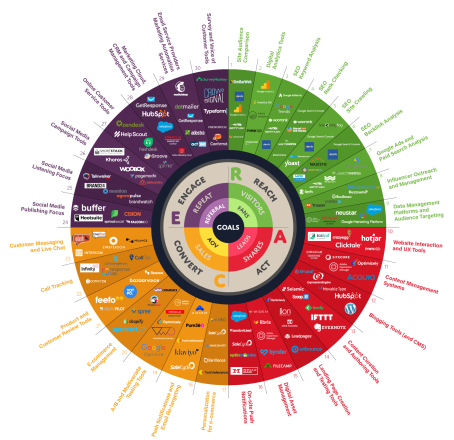
Discover other free and low-cost tools that can give you insight into your customers, competitors, and market. [Source]
B2B eCommerce
B2B eCommerce is a great marketing tool for manufacturers for a few reasons. First, it allows you to reach a wider audience beyond traditional sales channels. By having an online store, you can sell to customers who may not have been aware of your products before.
Second, B2B eCommerce enables manufacturers to showcase products in a more dynamic and interactive way than traditional sales methods. They can include detailed product descriptions, images, videos, and even virtual product demos. This can help customers better understand the products and their features, which can lead to increased sales.
Third, B2B eCommerce platforms can be integrated with other marketing tools, such as email marketing, social media, and content marketing. This allows manufacturers to create a comprehensive marketing strategy that reaches their target audience through multiple channels.
Discover more benefits of B2B eCommerce for manufacturers
What Real Manufacturers Have to Say
Whether you’re trying out adwords or aiming to increase visibility and conversions with a B2B ecommerce solution, there’s no single approach to marketing your business online.
Similarly, digital marketing can mean different things to different manufacturers. Those that adopted digital marketing have seen varying degrees of success. We reached out to manufacturers and asked them about their experience with digital marketing. Here is what they had to say.
Haimen Aibende Experimental Equipment
What made you look into digital marketing in the manufacturing industry?
“Before COVID-19, company representatives regularly went abroad to attend medical expos”, says Zhe Song of Haimen Aibende Experimental Equipment, a B2B manufacturer of medical lab disposables. Today, the company focuses its sights on PPC advertising.
Early on, ads on Baidu (China’s largest search engine) proved effective, helping with generating leads and phone calls. The company expanded to Alibaba’s P4P (pay for performance) program, increasing exposure to international buyers.
Discover what you can learn from the success of the Alibaba B2B business model.
What were the biggest challenges and how did you resolve them?
“SEO looked appealing and we all bought the idea,” says Zhe. However, it was put on the back-burner because of the complexity and delayed feedback loop. Nevertheless, SEO and SEM are two subjects now present in every meeting.
Zhe Song, Marketing Director, says:
Last year, Alibaba's paid ads got us a customer. Eventually, we exported three full 40' DC containers for an urgent government procurement for COVID-19 lab testing supplies in West Africa. We all thought the ad money was well spent and worth it.Mid Florida Material Handling
What made you evaluate digital marketing for manufacturing companies?
“The distribution industry is a bit behind the times from a technical perspective, admits Devin Ahern of Mid Florida Material Handling.
When the marketing team looked for ways to increase leads, they quickly realized that most people turn to Google when looking for a new supplier. The company’s foray into digital marketing started with PPC advertising using Google and Microsoft ads.
What were the biggest challenges and how did you resolve them?
“The biggest challenge was choosing the right platforms to meet our target audience,” says Devin. Many focus on social-media-based campaigns, heavily targeting paid Facebook, Instagram, or other social media ads. “We think for our business, which is primarily B2B, we were better off focusing on search engines.”
Devin Ahern, Marketing Manager, says:
Now that we've proven the concept with PPC, we've started to invest heavily into SEO and social media for organic rankings. Digital marketing is definitely a huge part of our marketing strategy now.Shaoxing Pariss Textile
What made you consider a digital marketing strategy for manufacturers?
The founders of Shaoxing Pariss Textile were looking to expand into digital even before the pandemic. As a 100% offline company, they understood that their customers could be anywhere, online and offline.
Since they’re a fabrics manufacturer, they had to focus on image-heavy social media: Instagram and Facebook. Shaoxing Pariss Textile also launched its website in March of 2021 and created landing pages for social media traffic.
What were the biggest challenges and how did you resolve them?
“Digital marketing is quite different from regular offline business,” admits Baron. The company had to carefully evaluate the product line, select the right color combinations, take professional photos, and compile product descriptions that would resonate with the buyer.
Baron Xu, Sales Manager, says:
With a website and social media accounts, we can upload new designs and update our blog in parallel. We learned that only useful and high-quality blog content about textile can bring us traffic.Tjernlund Products
What made you explore a digital marketing strategy for the manufacturing industry?
Tjernlund Products is an 83-year-old HVAC equipment manufacturer near Minneapolis. The company began using Google Adwords in the mid-2000s to drive traffic to their website and online retail store. While they saw some success, by the early 2010s they abandoned this strategy as it no longer delivered results.
What were the biggest challenges and how did you resolve them?
Tjernlund avoided digital marketing and only recently has explored running ads again via social networks. They learned that creating rich, compelling content around a “boring” B2B product is more challenging than they previously thought.
Andrew Tjernlund, Owner, says:
Today, content creation remains the main driver of Tjernlund’s digital marketing efforts.Digital Marketing for the Manufacturing Industry Is Here to Stay
While manufacturers are no strangers to technology when it comes to improving processes and productivity on the factory floor, many shy away from transformative initiatives in other business areas.
Change isn’t easy. Any digital transformation in manufacturing carries the risks of disrupting existing processes and relationships, incurring additional costs, and facing resistance from management.
It’s time for manufacturers to realize that the old ways of marketing don’t work in the digital age. Modern B2B buyers use digital or a combination of digital and traditional channels. The good news is that it’s never too late – even new entrants can get ahead of the competition in the digital world.
To help you get started, we created a guide to help marketing leaders, managers, and team leaders in the manufacturing industry take the first step into digital marketing. In it, we explain in greater detail how to develop a marketing strategy based on your needs, the challenges to expect, the common pitfalls to avoid, as well as tools to use.
Industrial Marketing In The Digital Age
A Guide to Digital Marketing for Manufacturers and Distributors
Questions and Answers
What is digital marketing for manufacturers?
Today’s business landscape is internet-focused, and a digital marketing strategy for a manufacturing company starts with a strong digital presence to attract buyers and grow sales. Like with any business, online marketing for manufacturing must include strategies to boost website traffic, convert traffic to leads, increase sales, and repeat purchases.
What are some digital marketing strategies for manufacturers?
Online marketing for manufacturers can range from optimizing websites for more traffic and more relevant traffic from search engines, paid advertisements, sending emails, or creating content. Like any business, manufacturers can increase their SEO results, run PPC campaigns, and create content, send email campaigns, and engage in social media marketing.
How can I market my manufacturing business online?
First, focus on your budget, assign a marketing team, then analyze your brand, audience, and competition. If you don’t have a website, build one. If you have a website, expand it with content, and focus on increasing the traffic to your website. Once you’ve done the basics, you can repeat what works, adjust what doesn’t, and keep making improvements.



